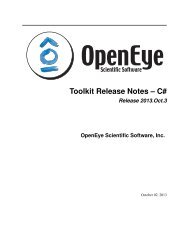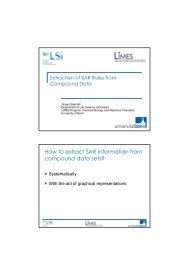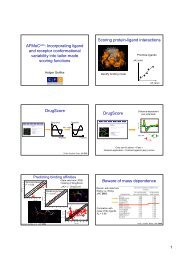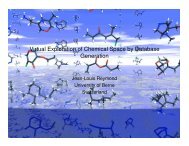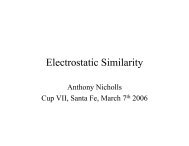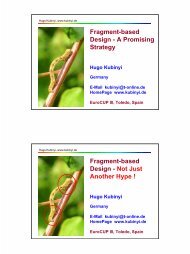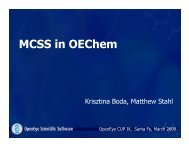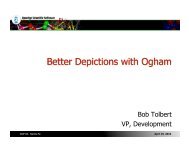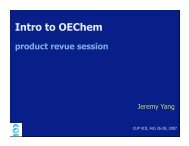Ensemble Docking Revisited
Ensemble Docking Revisited
Ensemble Docking Revisited
Create successful ePaper yourself
Turn your PDF publications into a flip-book with our unique Google optimized e-Paper software.
www.ccdc.cam.ac.uk<br />
<strong>Ensemble</strong> <strong>Docking</strong> <strong>Revisited</strong><br />
Oliver Korb<br />
Cambridge Crystallographic Data Centre<br />
korb@ccdc.cam.ac.uk
Outline<br />
Introduction<br />
Simulated <strong>Ensemble</strong> <strong>Docking</strong> / Screening<br />
GOLD <strong>Ensemble</strong> <strong>Docking</strong><br />
Future Work<br />
www.ccdc.cam.ac.uk
Introduction<br />
1a9u<br />
DFG in<br />
www.ccdc.cam.ac.uk<br />
1kv1<br />
DFG out<br />
induced fit effect in p38 MAP kinase
Introduction<br />
generating meaningful protein conformations during<br />
docking is a difficult task<br />
large-scale protein rearrangements can only hardly be<br />
modelled<br />
ensemble-based approaches only consider a set of<br />
discrete protein conformations<br />
www.ccdc.cam.ac.uk
Introduction – <strong>Ensemble</strong> <strong>Docking</strong> Literature<br />
Claussen et al. (FlexE) JMolBiol 308(2), 2001, pp 377-395<br />
Huang et al. (DOCK) Proteins 66(2), 2006, pp 399-421<br />
Rao et al. (Glide) JCAMD 22(9), 2008, pp 621-627<br />
Bottegoni et al. (ICM) JMedChem 52(2), 2009, pp 397-406<br />
Rueda et al. (ICM) JChemInfModel 50(1), 2010, pp 186-193<br />
Craig et al. (Glide) JChemInfModel 50(4), 2010, pp 511-524<br />
www.ccdc.cam.ac.uk
Multiple Protein Structure <strong>Docking</strong><br />
score<br />
1a9u<br />
74<br />
www.ccdc.cam.ac.uk<br />
1bl6<br />
60<br />
1bl7<br />
ligands get different scores in different protein structures<br />
scores determine ranking performance in virtual screening<br />
which protein structure(s) to use for virtual screening?<br />
69
Sensitivity of Virtual Screening Results<br />
AUC EF (all act.) EF 10%<br />
target # proteins min max delta min max delta min max delta<br />
acetylcholine esterase 21 0.41 0.70 0.29 0.0 8.8 8.8 0.4 4.6 4.2<br />
aldose reductase 32 0.40 0.64 0.24 4.1 15.1 11.0 2.3 5.0 2.7<br />
cyclin-dependent kinase 2 72 0.42 0.71 0.29 1.4 14.4 13.0 0.8 5.2 4.4<br />
dihydrofolate reductase 9 0.56 0.83 0.27 2.3 9.3 7.0 1.7 4.9 3.2<br />
factor Xa 34 0.67 0.88 0.21 4.7 16.7 12.0 3.0 7.5 4.5<br />
heat shock protein 90 30 0.68 0.88 0.20 1.5 11.8 10.3 2.1 7.1 5.0<br />
neuraminidase 13 0.77 0.85 0.08 2.2 11.8 9.6 2.4 5.5 3.1<br />
p38 MAP kinase 31 0.42 0.74 0.32 0.9 10.6 9.7 0.5 3.9 3.4<br />
phosphodiesterase 5A 5 0.67 0.74 0.07 7.9 10.7 2.9 3.7 5.1 1.4<br />
www.ccdc.cam.ac.uk
score<br />
Simulated <strong>Ensemble</strong> <strong>Docking</strong><br />
1a9u<br />
74<br />
www.ccdc.cam.ac.uk<br />
1bl6<br />
60<br />
1bl7<br />
for each ligand pick the best-scoring protein structure<br />
simulates a perfect ensemble docking approach<br />
69
Simulated <strong>Ensemble</strong> <strong>Docking</strong><br />
perform docking / screening for n protein structures<br />
2 n<br />
n<br />
k<br />
1<br />
example n = 12<br />
• 4095 different ensembles<br />
simulate docking into all<br />
2 1ensembles<br />
by postprocessing<br />
n docking results<br />
n<br />
www.ccdc.cam.ac.uk<br />
different ensembles (size 1 or greater)<br />
ensembles of size k
Simulated <strong>Ensemble</strong> <strong>Docking</strong><br />
exhaustive enumeration of all ensembles infeasible<br />
for large n<br />
cdk2: 72 structures<br />
72<br />
36<br />
442 quintillion ensembles<br />
www.ccdc.cam.ac.uk<br />
100,000
Targets<br />
target PDB # holo proteins a # actives # inactives<br />
acetylcholine esterase 1gpk 21 105 3623<br />
aldose reductase 1t40 32 26 902<br />
cyclin dependent kinase 2 1ke5 72 50 1661<br />
dihydrofolate reductase 1s3v 9 201 6496<br />
factor Xa 1lpz 34 141 4535<br />
heat shock protein 90 2bsm 30 24 823<br />
neuraminidase 1l7f 13 49 1726<br />
p38 MAP kinase 1ywr 31 240 8203<br />
phosphodiesterase 5A 1xoz 5 51 1808<br />
www.ccdc.cam.ac.uk<br />
curated DUD b set<br />
pose prediction results averaged over 20 independent runs<br />
virtual screening: single run with autoscale = 1.0<br />
a Verdonk et al. JCIM, 48, 2214-2225 (2008)<br />
b Huang et al. JMedChem, 49, 6789-6801 (2006)
Assessing <strong>Ensemble</strong> <strong>Docking</strong> Performance<br />
a good ensemble scoring function should<br />
– exhibit a good cross-docking performance<br />
– discriminate well between correctly and incorrectly docked<br />
solutions<br />
cross-docking performance: number of correctly predicted<br />
poses in non-native protein structures<br />
discrimination performance: calculate AUC for<br />
discrimination between correctly and incorrectly docked<br />
solutions (ranked by fitness)<br />
www.ccdc.cam.ac.uk
Assessing <strong>Ensemble</strong> <strong>Docking</strong> Performance<br />
www.ccdc.cam.ac.uk<br />
cross = 59 %<br />
AUC = 0.95<br />
a a<br />
each data point represents the docking result for one protein structure (72 for CDK2)<br />
a correct if top-ranked solution rmsd < 2 Å, incorrect otherwise
Assessing <strong>Ensemble</strong> <strong>Docking</strong> Performance<br />
www.ccdc.cam.ac.uk<br />
cross = 48 %<br />
AUC = 0.33<br />
a a<br />
each data point represents the docking result for one protein structure (30 for HSP90)<br />
a correct if top-ranked solution rmsd < 2 Å, incorrect otherwise
<strong>Ensemble</strong> <strong>Docking</strong> – Pose Prediction<br />
AUC a # correct # proteins % correct rank b improvement c<br />
CHEMPLP<br />
acetylcholine esterase 0.55 10 20 50 1<br />
aldose reductase 0.83 15 31 48 1<br />
cyclin dependent kinase 2 0.95 42 71 59 2<br />
dihydrofolate reductase 1.00 7 8 88 1<br />
factor Xa 0.61 16 33 48 1<br />
heat shock protein 90 0.33 14 29 48 1<br />
neuraminidase 1.00 12 12 100 1<br />
p38 MAP kinase 0.65 3 30 10 5<br />
phosphodiesterase 5 1.00 2 4 50 1<br />
avg. 0.77 56<br />
GOLDSCORE<br />
acetylcholine esterase 0.22 2 20 10 15<br />
aldose reductase 0.89 11 31 35 2<br />
cyclin dependent kinase 2 0.75 36 71 51 1<br />
dihydrofolate reductase 0.58 6 8 75 1<br />
factor Xa 0.66 26 33 79 1<br />
heat shock protein 90 0.77 26 29 90 1<br />
neuraminidase 1.00 12 12 100 1<br />
p38 MAP kinase 0.51 3 30 10 2<br />
phosphodiesterase 5 1.00 1 4 25 1<br />
avg. 0.71 53<br />
a discrimination between correctly and incorrectly predicted solutions<br />
b rank of first correctly docked solution<br />
c if ensemble docking performs better than the average single protein structure, otherwise<br />
www.ccdc.cam.ac.uk
Virtual Screening – Heat Shock Protein 90<br />
medium improvement<br />
www.ccdc.cam.ac.uk<br />
no improvement
Virtual Screening – Dihydrofolate Reductase<br />
medium improvement medium improvement<br />
www.ccdc.cam.ac.uk
Virtual Screening – Factor Xa<br />
major improvement<br />
www.ccdc.cam.ac.uk<br />
major improvement
Virtual Screening – Phosphodiesterase 5A<br />
medium improvement<br />
www.ccdc.cam.ac.uk<br />
major improvement
Improving Upon the Best Single Protein Structure<br />
protein 1<br />
L1<br />
D<br />
L2<br />
70<br />
50<br />
40<br />
protein 2<br />
L2<br />
D<br />
L1<br />
www.ccdc.cam.ac.uk<br />
60<br />
45<br />
30<br />
ensemble<br />
L1<br />
L2<br />
D<br />
70<br />
60<br />
50<br />
… but also<br />
PDE5<br />
CDK2
Virtual Screening Results<br />
target AUC EF (all act.) EF 10%<br />
acetylcholine esterase<br />
aldose reductase<br />
cyclin dependent kinase 2<br />
dihydrofolate reductase<br />
factor Xa<br />
heat shock protein 90<br />
neuraminidase<br />
p38 MAP kinase<br />
phosphodiesterase 5A<br />
ensemble performance compared to average performance of single protein structures<br />
no improvement<br />
medium improvement<br />
major improvement<br />
www.ccdc.cam.ac.uk
GOLD ensemble<br />
results so far based on sequential docking<br />
modified genetic algorithm to treat protein ensembles<br />
requires a superimposed set of protein structures<br />
searches all protein conformations<br />
concurrently<br />
www.ccdc.cam.ac.uk
GOLD ensemble - Fitting Points<br />
www.ccdc.cam.ac.uk
GOLD ensemble – Genetic Algorithm<br />
mapping<br />
degrees of<br />
freedom<br />
www.ccdc.cam.ac.uk<br />
protein degrees<br />
of freedom<br />
ligand degrees<br />
of freedom<br />
protein ID<br />
for n protein structures selects protein<br />
structure for scoring<br />
ID mode: change the protein during the GA-search by mutation<br />
island mode: search all protein structures concurrently
GOLD ensemble – Island Mode<br />
protein ID: 1 protein ID: 2 protein ID: 3 protein ID: 4<br />
island 1 island 2 island 3 island 4<br />
up to four times faster than sequential docking depending on the number of proteins and ligand size<br />
www.ccdc.cam.ac.uk
Conclusions<br />
ensemble docking can improve hit rates<br />
• increases worst and average case performance in many cases<br />
• performs sometimes as good as the best single protein structures<br />
trends suggest to use multiple protein structures in an<br />
ensemble protocol (minimise the risk of picking a bad one)<br />
GOLD has been extended to search ensembles timeefficiently<br />
www.ccdc.cam.ac.uk
Future Work<br />
analysis of chemotype enrichment<br />
investigation of protein energies<br />
combine ensemble docking with flexible side-chains<br />
and switching of explicit water<br />
molecules<br />
www.ccdc.cam.ac.uk



